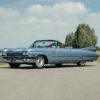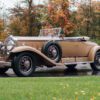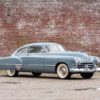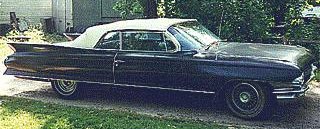Cadillac Models & History 1961

The Sixties brought few engineering advances of the sort that had earned Cadillac such great renown during the previous 20 years. Its most technically interesting car of this decade was the front-drive Eldorado, introduced for 1967. The smallest Cadillac since the last 1940 LaSalle, it combined mechanical innovation with traditional Cadillac lines that still look good today.
But it was consistently good styling across the broadest model line in the luxury field that helped Cadillac to new sales records most every year during the Sixties. The company’s gradual transition from glittery excess to stately elegance seemed to anticipate the luxury buyer’s tastes.
The cleanup began right away with a facelifted 1960 line bearing simpler grilles and lower-profile fins. Offerings stayed the same, as did prices, ranging from $4892 for the Series 62 hardtop coupe to $9748 for the big Series 75 limousine. Mechanical specifications also stood pat. Standard horsepower remained 325, with 345 reserved for the Eldorado Biarritz convertible and Seville hardtop coupe, both courtesy of the 390-cubic-inch V-8 introduced for 1959.
Series 62 remained the volume leader, but the mid-range DeVille, another ’59 development, was coming on strong. As before, both series had no pillared sedans but did offer two hardtop four-doors: a flat-top “Vista roof” job with radically wrapped backlight, and a more conventional “six-window” style with rear-door ventpanes. Returning for its final year was the Eldorado Brougham hardtop sedan, unchanged from ’59 as an evolution of the intriguing but unsuccessful 1957-58 model. Still priced at a towering $13,075 but now boasting bodywork by Pininfarina of Italy, it sold only 101 copies in 1960 — less than even the original Brougham’s 704. Worse, they were built nowhere near as well. Overall, Cadillac remained 10th in model-year production for 1960 (a position held since ’58) and would remain there through 1964, though that was still impressive for a luxury make.
Carrying another new GM C-body, the ’61s were the cleanest Cadillacs in years. They were also the first influenced by William L. Mitchell, who had been installed as GM design chief in 1958. Mitchell favored a more chiseled look than his predecessor, Harley Earl, and wasn’t as enamored of chrome. Grilles became a prominent grid, while fins were trimmed again. The Eldorado Seville disappeared with the Brougham, while the Biarritz was down-graded to the standard 325-bhp V-8.
HISTORICAL NOTES
- Total model year output for all 1961 cars amounted to 138,379 units.
- A limited slip differential was optional at $53.70.








